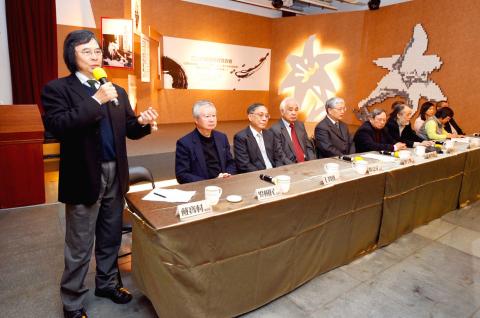The Chinese Nationalist Party (KMT) should be required to open party archives to allow academics to search for a list of people targeted during the 228 Incident, a leading expert on Taiwanese history said yesterday.
“We talk a lot about recovering the KMT’s ‘ill-gotten assets,’ but for some reason, no one seems to talk about recovering the documents stored in the party archives,” Academia Sinica’s Institute of Taiwan History research fellow Hsu Hsueh-chi (許雪姬) said at a commemorative event held at the National 228 Memorial Museum.
The KMT has been reluctant to open its historical archives in the absence of a formal legal obligation, despite ruling the nation as a one-party state for more than 50 years, Hsu said.

Photo: Lo Pei-der, Taipei Times
“The most important documents we are missing are the KMT’s; we have only seen a small proportion of the material relating to Taiwan Province,” she said. “At the very least, KMT officials would have written down any decisions that were made. Because the party led the government, those decisions would have been what government agencies implemented, so in some ways, KMT documents are a step up from official archives.”
Information on decisionmaking from the archives could shed light on how and why 228 Incident victims were targeted, she said, adding that a “name list” of targeted individuals was the key “missing link” in recent research.
The 228 Incident refers to the crackdown launched by the Chinese Nationalist Party (KMT) regime against civilian demonstrations following an incident in Taipei on Feb. 27, 1947. The event also marked the beginning of the White Terror era that saw thousands of Taiwanese arrested, imprisoned and executed.
“We do not know if the list of names [of 228 victims] was provided by a [Taiwanese] banshan [“half mountain,” a reference to those Taiwanese who went to China and joined the KMT during Japanese colonial rule], or by KMT sympathizers or others — but there must have been a list, because the regime was very methodical in making arrests,” Hsu said, adding that it was clear that intelligence agents had infiltrated opposition groups, enabling the extensive “payback,” which followed the uprising.
Other missing pieces included the division of labor between the military, police and intelligence services, as well as the exact fates of most victims, she added.
Based on the available documents, it is still impossible to determine the exact number of victims of the incident, National Central University history professor Lai Jeh-hang (賴澤涵) said.
Estimates for the number of people injured or killed range widely, from thousands to tens of thousands, with the 228 Memorial Foundation as of August last year having provided compensation in 2,288 cases, according to the foundation’s Web site.

Three Taiwanese airlines have prohibited passengers from packing Bluetooth earbuds and their charger cases in checked luggage. EVA Air and Uni Air said that Bluetooth earbuds and charger cases are categorized as portable electronic devices, which should be switched off if they are placed in checked luggage based on international aviation safety regulations. They must not be in standby or sleep mode. However, as charging would continue when earbuds are placed in the charger cases, which would contravene international aviation regulations, their cases must be carried as hand luggage, they said. Tigerair Taiwan said that earbud charger cases are equipped

UNILATERAL MOVES: Officials have raised concerns that Beijing could try to exert economic control over Kinmen in a key development plan next year The Civil Aviation Administration (CAA) yesterday said that China has so far failed to provide any information about a new airport expected to open next year that is less than 10km from a Taiwanese airport, raising flight safety concerns. Xiamen Xiangan International Airport is only about 3km at its closest point from the islands in Kinmen County — the scene of on-off fighting during the Cold War — and construction work can be seen and heard clearly from the Taiwan side. In a written statement sent to Reuters, the CAA said that airports close to each other need detailed advanced

Tropical Storm Fung-Wong would likely strengthen into a typhoon later today as it continues moving westward across the Pacific before heading in Taiwan’s direction next week, the Central Weather Administration (CWA) said. As of 8am, Fung-Wong was about 2,190km east-southeast of Cape Oluanpi (鵝鑾鼻), Taiwan’s southernmost point, moving westward at 25kph and possibly accelerating to 31kph, CWA data showed. The tropical storm is currently over waters east of the Philippines and still far from Taiwan, CWA forecaster Tseng Chao-cheng (曾昭誠) said, adding that it could likely strengthen into a typhoon later in the day. It is forecast to reach the South China Sea

WEATHER Typhoon forming: CWA A tropical depression is expected to form into a typhoon as early as today, the Central Weather Administration (CWA) said yesterday, adding that the storm’s path remains uncertain. Before the weekend, it would move toward the Philippines, the agency said. Some time around Monday next week, it might reach a turning point, either veering north toward waters east of Taiwan or continuing westward across the Philippines, the CWA said. Meanwhile, the eye of Typhoon Kalmaegi was 1,310km south-southeast of Oluanpi (鵝鑾鼻), Taiwan’s southernmost point, as of 2am yesterday, it said. The storm is forecast to move through central